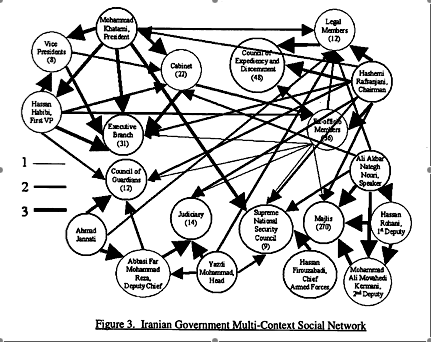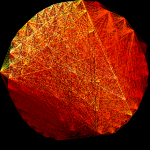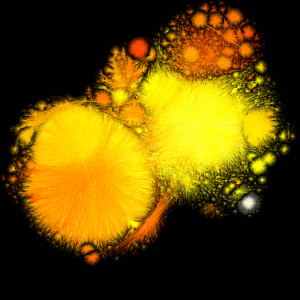 In honor of the Iranian election, here’s the 2001 social network analysis of the Iranian government by Renfro and Deckro.
In honor of the Iranian election, here’s the 2001 social network analysis of the Iranian government by Renfro and Deckro.
Category: Uncategorized
Kiva Micro-Lending Offers API
 Incredibly great idea Kiva.org, the distributed micro-lending organization, has recently released a freely available API for accessing their data.
Incredibly great idea Kiva.org, the distributed micro-lending organization, has recently released a freely available API for accessing their data.
I have just started poking at the data available, as I suspect network analysis will be able to help predict rates of return.
Good on ‘ya Kiva!
Update: hi-res image by request from smoovej
Andreas Kluth and the Campfire
Great podcast interview with the Economist‘s Andreas Kluth contrasting social media and the communication around the campfire.
“We were all awkward as teenagers … if I had had already Facebook and such media available to me I would have probably been completely impossible to talk to now. Because of course, there is a certain brain exercise involved in communicating face to face: cues and voice and body language and so forth. Knowing not when to interrupt someone.”
From way back at the end of oh-7, and still a great listen.
/Message: Authority Is A Highly Charged Particle
I’ve discussed my thoughts on authority before and I think follower count is a poor measure; but Stowe Boyd as has a great post (where the name for this post came from) summing up much of the controversy.
Two things I particularly like about the post: his spelling out why follower count is not without merit as a measure, and his unshy conviction that influence is a good thing.
To these I’ll add one short thought and one quote. Follower count, for all of its failings is the single measure we can all agree on. That alone is powerful. As for influence:
It is the pressure of our peers, after all, that gives us the support to try things we otherwise wouldn’t have. — BILL TREASURER, Right Risk
A very happy, healthy, and prosperous New Year to you and your social network. Keep connecting.
Beautiful, Beautiful Data
Flip over at InfoChimps has put together a massive scrape of twitter. While trying to figure out how to process it all, I’ve drawn one day’s scrape* (20-Dec-08). Many thanks to Flip and InfoChimps for the wow work, and doubly so for making publicly available.
A brief history of communication
A breif History of communication from ljudbilden on Vimeo.
Yes, it’s an ad, but who can say no to stop-motion history?
[via neatorama]
Social Networks of the Senate

I always enjoy analyzing social networks (SN’s) that have had a lot less press than the Goliaths of MySpace and Facebook. I have done an awful lot of them, but one of my favorites was looking at the co-sponsorship patterns in the US Senate, 110th session (the current one).
This analysis was especially enjoyable because the graph is just one giant cluster, so conclusions took some real digging. So, what did we learn?
We learned a few things: graphs are just the beginning of analysis (but we knew that already); not all junior Senators are as strategic as others; and directionality of the relationships can have a large impact.
There are a handful of junior Senators setting themselves up for favor by strategically co-sponsoring specific bills. However, most junior Senators are building reputation by supporting anything that makes it to the floor. I am going to have to go back and analyze previous sessions to see which approach seems to provide the better payoff.
Relationships by-and-large are unequal between participants. Sometimes they are very close, sometimes they are very different. In our analysis of the Senate, many of these relationships are very unequal; a junior Senator is much more likely to co-sponsor a bill of a senior Senator than vice versa. Without bringing this inequality into play, our notion of network centrality is challenged. In this case, the two Senators most central include one first elected in 2004, followed closely by one who is a member of the powerful Senate Appropriations Committee. If we view networks as expressions of influence over flow of information, including favors, that just doesn’t make sense.
When we start to bring directionality into consideration, which I did by splitting out the sponsors and co-sponsors for half of the Senate’s 104th session (1995); results become much more as expected. The most central Senator was John Warner, then president pro tem.
Your network: for or against you?

Your network can help you or work against you, it all depends on the level alignment between your network and your goals. If you are trying to get something done with a team, your network should reflect that. If you are looking for new opportunties, your network should reflect that.
I wrote a short piece for Pollock|Spark about personal networks and suggesting people beginning thinking about the power of networking to help meet their goals.
Every book on sales, finding a new job, etc. stress the importance of networking, and rightly so. While is certainly easier for some than others, the validity to networking is no longer the question. The question you want to ask yourself is: who?
Over our lifetimes of participating with networks ranging from work, to family, to neighborhoods, to hobbies; we accumulate many contacts. There are significantly more effective and efficient ways to spread the word than reaching out to everyone you know, if you know your network.
Let’s go through a few hints, using the image in this article created from my personal email over the past year or so. Click on the image to blow if up larger.
- Respect your friends and colleagues. If you abuse their hospitality and trust, not only will you lose them, but you’re also done for.
- Don’t spend equal time with everyone. Some people can help you more than others.
- If everyone in a group knows each other, only spend time on only a handful of people. When everyone knows each other, the network is dense. Many of the orange and yellow clusters in the image are dense.
- Make a special effort with people that connect one or more of your groups.
Visualizing Your Professional Networks

I spend much of my waking time thinking about how relationships between individuals in groups effect the behavior of the individuals and of the group itself. One tool I recently put together looks at professional relationships from LinkedIn.com.
Attached is a representation of the relationships between the 17,000 people my work contacts know. This is how we know us.
If you want to know what your network looks like, drop me a line.
This is…How We Know Us

We are only beginning to gain an understand about how group decision making works, and the dynamics of the rolls individuals play in the process; despite a strong and accumulating academic history.
With the rise in data availability through Social Networks, the potential for learning and profit are unprecedented in this field, but so is the necessity for exploring the ethical implications of the practice.
This site is named for the idea that the way individuals aggregate into networks gives us a picture of influence over the flow of information and opinions within. Together, these help define our own opinions of everything, including ourselves. This is How We Know Us
